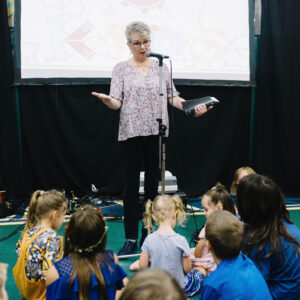 I began telling Bible stories long before I started writing novels. And I learned to tell parables–tales used to illustrate moral or spiritual lessons–when I fell in love with the best-selling Author of all time. Who is that best-selling Author? According to Google’s AI overview:
I began telling Bible stories long before I started writing novels. And I learned to tell parables–tales used to illustrate moral or spiritual lessons–when I fell in love with the best-selling Author of all time. Who is that best-selling Author? According to Google’s AI overview:
The Guinness Book of World Records reports the Bible has sold between 5 and 7 billion copies since it was standardized around 1500 years ago, making it the best-selling publication of all time.
That’s right. The Creator of Heaven and Earth is not only THE best-selling Author of all time, but He’s written His best-selling Book as a compilation of stories that meld into a single parable in which YOU are one of the characters. Crazy, huh?
The God Who Created Us To Be Creative
It all makes sense when we realize the same God who created all things also created every human being in His image.
So God created mankind in his own image, in the image of God he created them; male and female he created them. Genesis 1:27 (NIV)
 As part of being created in the image of God, He gave us the ability to create. When I teach at writer’s conferences, I have my classes repeat this phrase so they remember the very important truth. Let’s say it aloud so it becomes personal:
As part of being created in the image of God, He gave us the ability to create. When I teach at writer’s conferences, I have my classes repeat this phrase so they remember the very important truth. Let’s say it aloud so it becomes personal:
I was created by the Creator to be creative. I was created by the Creator to be creative.
That doesn’t mean God created everyone to write books or parables or to be artists or sculptors. Being creative comes in many forms! My six-year-old grandson, Asher, just created a whole new superhero called, Fartman, who kills bad guys with this green, odorous gas. Now, THAT’S creative!
How To Save A Cat

It’s been over two years since I discovered the strangest title on a book that’s become the most effective writing help I ever found. Save the Cat: Writes a Novel by Jessica Brody helped me see the overall structure of EVERY STORY EVER WRITTEN. Yes, that includes the Bible! Did you realize the Bible has a single, over-arching plot with several “parables” or subplots within it.
Wait. Aren’t parable’s like fairy tales? Aren’t parables FICTION? Oooh! Good point!
The whole Bible is TRUTH. Inerrant. The living words of the Eternal God.
A parable–as I’ve seen it defined–is simply a story told to teach a moral or spiritual lesson. So the Bible, and every story about the REAL PEOPLE in it, should be considered more like biographies. Whatever truths we read about the people in Scripture are absolutely true, but they can also teach us. Maybe those stories qualify as a TRUE Parable.
When I write a biblical novel, I include the Bible’s TRUTH but also add historical findings and scholars opinions with my own imagination to create a parable that feels real. I do that with prayerful consideration and lots of historical research–a little more preparation than the sound effects and quickly imagined characters I added to my daughters’ bedtime stories! 😉 CLICK HERE to check out my books and read a sample chapter of any book to see how I mingle God’s Truth, historical fact, and creative fiction into a novel-length parable.
How The Creator Saved the Cat–Before Jessica Brody Wrote Her Book
God wrote His TRUE Story (Genesis to Revelation) using a compilation of sixty-six books. Some Bible books tell people’s stories, like Genesis, Kings, the Gospels, and Acts. Others focus on a single story or theme (Ruth, Job, Philemon). But the Bible doesn’t just tell stories. It also includes other genres in its sixty-six books: poetry, apocalyptic (prophetic), and wisdom literature. By His miraculous, omniscient power, El Elyon–the Creator who spans all time and space–dictated His living Word to forty human scribes who wrote sixty-six books during a period of 1500 years on three continents using three different languages.
And it tells ONE TRUE STORY from Genesis to Revelation. Sit with that for a moment. Let awe of His vastness and majesty settle into your heart.
Save the Cat (STC) says: Every Story Needs a Story-Worthy Hero
STC helps an author create a main character with three powerful motivators–a problem, a need, and a want–that can carry them through an action-packed parable.
The Bible’s Main Character: God Himself
-
- PROBLEM: The Creation He formed in His own image–who He invited to live in perfect communion with Father, Son, and Spirit–betrayed His love and disobeyed His command. The Serpent deceived Eve, so she and Adam decided their way was better than God’s. They believed the monster instead of the Master.
- WANT: God’s goal through the entire Bible is to restore that perfect relationship of the Garden, so He can once again commune as Father, Son, and Holy Spirit with those who love Him and choose His way over the monster’s lies.
- NEED: (This is a hard one because God doesn’t need to LEARN anything–so the “life lesson” or theme is more so about revealing God’s HEART to readers as each subsequent story through millennia shows Him patiently working to restore the perfect relationship that was lost.)
STC says: Every Story Fits Within One of TEN Genres
There are tens of millions of novels dating back to ancient times. Very smart people have studied various types of novels and grouped them into ten “archetypes” or genres.
The Bible’s Genre: A Monster In the House (the Serpent)
God (in concert with the Son and Holy Spirit working through humankind and their freedom to choose Him over sin) must overcome the Serpent from the Garden (Satan’s name means Accuser, Rev. 12:10), in some kind of enclosed setting (Satan is ruler of this world, John 12:31), and someone is usually responsible for bringing the monster into being. (God created the fallen angels, and humans who freely choose to worship God will one day judge the angels who refused to worship Him – 1 Cor. 6:3.)
STC says: Every Story Must Teach At Least One of Ten Life Lessons
When writing a highly emotional and/or relatable book, it must connect with readers in real-life lessons about their daily lives. STC helps us narrow those life lessons down to 10 General Lessons:
- FORGIVENESS: of oneself or others
- LOVE: includes self love, family love, romantic love
- ACCEPTANCE: of oneself, of circumstances, of reality
- FAITH: in oneself, in others, in the world, in God
- FEAR: overcoming it, conquering it, finding courage
- TRUST: in oneself, in others, in the unknown
- SURVIVAL: including the will to live
- SELFLESSNESS: including sacrifice, altruism, heroism, and overcoming greed
- RESPONSIBILITY: including duty, standing up for a cause, accepting one’s destiny
- REDEMPTION: including atonement, accepting blame, remorse, and salvation
The Bible’s Life Lesson: All 10!
In the Grand Parable of Genesis to Revelation, there are whispers of every life lesson. Forgiveness. Selflessness. And, of course, redemption! Remember, STC is NOT a Christian book. Yet notice how God’s wisdom permeates even the most ancient foundations of novel-writing through the ages.
STC Says: Use 15 Beats (Sign-Posts) to Plot Your Story’s Progression
Each of the fifteen markers describes a scene or group of scenes that propel your main character(s) through their transformative journey to learn their life lesson and satisfy your reader.
Now, About The Bible’s Beats…
Because not all of my newsies are writers, I won’t bore you with all the technical stuff about First Act, Midpoint, and all that. Let me just show you the most profound thing I discovered about how the Creator knew about STC before Ms. Brody ever wrote it…so you can marvel with me (take my word for it) about the other amazing stuff I’ve discovered about the best-selling Author of all time.
Be sure you take special notice of the Opening Image and Final Image. First, think about the Bible’s “opening image.” What comes to mind when you think of God’s Creation?
The Lord God formed a man from the dust of the ground and breathed into his nostrils the breath of life, and the man became a living being. Now the Lord God had planted a garden in the east, in Eden; and there he put the man he had formed. The Lord God made all kinds of trees grow out of the ground…A river watering the garden flowed from Eden; from there it was separated into four headwaters. Genesis 2:7–10 (NIV – emphasis added)
STC Beat #1: Opening Image = A garden
Then God enjoys fellowship, and we understand Beat #2 Theme and #3 Setup. Then comes #4 Catalyst–and we also define the genre, “Monster in the House,” when the Serpent shows up in the forbidden tree.
Now the serpent was more crafty than any of the wild animals the Lord God had made. He said to the woman, “Did God really say, ‘You must not eat from any tree in the garden’?”The woman said to the serpent, “We may eat fruit from the trees in the garden, but God did say, ‘You must not eat fruit from the tree that is in the middle of the garden, and you must not touch it, or you will die.’ ”“You will not certainly die,” the serpent said to the woman. “For God knows that when you eat from it your eyes will be opened, and you will be like God, knowing good and evil.”When the woman saw that the fruit of the tree was good for food and pleasing to the eye, and also desirable for gaining wisdom, she took some and ate it. She also gave some to her husband, who was with her, and he ate it. Genesis 3:1–6 (NIV)
The Garden sin changed not only Adam’s and Eve’s lives but also deeply affected God. On that day, His beloved Creation became war prisoners of His worst enemy (Satan/Serpent)–now shackled by sin and death. His kids’ disobedience separated them from their holy Creator, destroyed their innocence, and would introduce them and their offspring to pain and death.
STC Beat #6: Break Into 2 = Cursing the Monster
This is the Scripture that proved to me Jesus was present through the whole Bible, and God was loving on every page of the Old AND New Testaments:
[God said to the Serpent,] “And I will put enmity between you and the woman, and between your offspring and hers; he will crush your head, and you will strike his heel.” Genesis 3:15 (NIV)
The Guts of the Story
God could have turned His back on Adam and Eve. Instead, God pursued them. He promised to FIX the problem HIMSELF–through Eve’s offspring. The woman who brought sin and separation to the world would, through her offspring, bring life and reconciliation. Though the serpent’s offspring would strike her offspring’s heel (Jesus’s death on the cross), the Redeemer would crush the serpent’s head (Jesus’s resurrection) and somehow restore Garden fellowship (Jesus’s Second Coming).
The rest of the Bible–Old and New Testament–tells God’s story of reconciliation. It shows us the careful record of Eve’s lineage to prove Jesus was her offspring. Through God’s chosen people, His parable was told, recorded, and preserved. Through the Gospel accounts and early church epistles, God’s epic march toward redemption continued. As all believers in His Church enjoy renewed fellowship through the Holy Spirit with the Father through the power and resurrection of Jesus, God’s Son, communion has been restored–but only dimly as in a reflection–not completely as it was in the Garden…
As a writer, I’ve read through the STC beats from Debate to Finale. I’ve also read the ups and downs of God’s people through the patriarchs, prophets, priests, kings, a Messiah, disciples, apostles, the Church, and we’re still wait on the fulfillment of those things we read in Revelation. When we turn to the last pages of the last Book of God’s TRUE story, He tells us the end before we experience it. It’s a spoiler, for sure, but a glorious one! Startling proof of the best-selling Author’s genius.
STC Beat #15: The Final Image = A Mirror to the Opening Image
If our hero were human, the final image would be a snapshot of who he’d become after his epic transformation. Since our Hero is God–the same yesterday, today, and forever–the final image instead gives us a snapshot of His changed surroundings–the new and improved Garden that awaits us when we’re FULLY reunited in perfect fellowship with our Creator…
“Then the angel showed me the river of the water of life, as clear as crystal, flowing from the throne of God and of the Lamb down the middle of the great street of the city. On each side of the river stood the tree of life, bearing twelve crops of fruit, yielding its fruit every month. And the leaves of the tree are for the healing of the nations. No longer will there be any curse. The throne of God and of the Lamb will be in the city, and his servants will serve him. They will see his face, and his name will be on their foreheads. There will be no more night. They will not need the light of a lamp or the light of the sun, for the Lord God will give them light. And they will reign for ever and ever.” Revelation 22:1–5 (NIV)
What a perfect ending! No wonder it’s a best-seller every year. God’s perfect plan, perfectly written, perfectly true, and perfectly offered to every imperfect person who will accept the loving Sacrifice Jesus paid for our sins.
Want to Share This Post?
Return to today’s newsletter (1/13/25) and scroll all the way to the bottom. Then click and share using the Facebook or email icons to forward the newsletter (including this post) to friends and family.
Thanks for being my Newsie!



